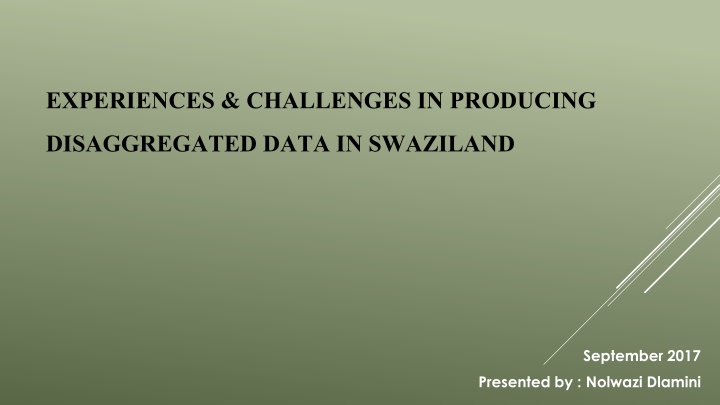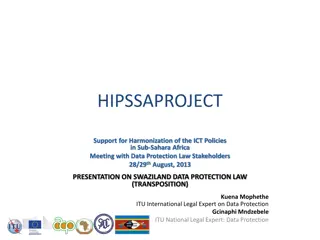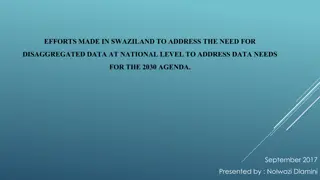
Challenges and Support for Data Disaggregation in Swaziland
Explore the experiences and challenges in producing disaggregated data in Swaziland, including national data sources, experiences with producing disaggregated data by SDG indicators, and challenges faced at all levels. Discover the support required to unlock the full potential for data disaggregation of key indicators for vulnerable groups.
Download Presentation

Please find below an Image/Link to download the presentation.
The content on the website is provided AS IS for your information and personal use only. It may not be sold, licensed, or shared on other websites without obtaining consent from the author. If you encounter any issues during the download, it is possible that the publisher has removed the file from their server.
You are allowed to download the files provided on this website for personal or commercial use, subject to the condition that they are used lawfully. All files are the property of their respective owners.
The content on the website is provided AS IS for your information and personal use only. It may not be sold, licensed, or shared on other websites without obtaining consent from the author.
E N D
Presentation Transcript
EXPERIENCES & CHALLENGES IN PRODUCING DISAGGREGATED DATA IN SWAZILAND September 2017 Presented by : Nolwazi Dlamini
NATIONAL DATA SOURCES CENSUSES SURVEYS LINE MINISTRIES & AGENCIES ADMINISTRATIVE SOURCE NEW PARTNERSHIPS Income & expenditure survey MICS Labour force Survey Intercensal Survey Agriculture Survey MOH MOE Population and Housing Census CRVS Report SHIMS Economic Census Agriculture Census
EXPERIENCES WITH PRODUCING DISAGGREGATED DATA BY SDG INDICATORS Age ranges by which data is disaggregated are 5 year age groups and 10 year age groups All household surveys and censuses further disaggregate by sex Disaggregation by disability status is a new concept that was introduced in the 2017 Population & Housing Census Disaggregation by race/ ethnicity is not applicable to our country, although we do collect information on citizenship
CHALLENGES WITH PRODUCING DISAGGREGATED DATA AT ALL LEVELS Legal framework for official statistics: The Statistics law is being reviewed and updated No coordination body; The current situation of statistical production produced by line ministries and agencies is decentralized Different conceptual framework on classification and methodologies recommended by international organizations Challenges in terms of how to utilize the new and emerging data sources Insufficient funding, coordination, integration (surveys) to achieve the required disaggregation Inadequate staff and statistical expertise to meet increased demand for disaggregated data
SUPPORT REQUIRED INORDER TO UNLOCK THE FULL POTENTIAL FOR DISSAGGREGATION OF KEY INDICATORS FOR VULNERABLE GROUPS Training/capacity building on integrating data disaggregation in existing tools and processes for producing and disseminating data in line with Agenda 2030 Capacity building on Designing of more appropriate or effective methodologies for data disaggregation Financial resources and capacity building for adopting new data sources and innovative data integration techniques and data compilation procedures Strengthening of Coordination and collaboration not only within NSS and stakeholders at country level, but also regional and international level Development of special area survey instruments and their implementation e.g module for disability survey and informal sector survey Development of a conceptual framework and methodology for identifying how data should be disaggregated for a specific service or policy.






